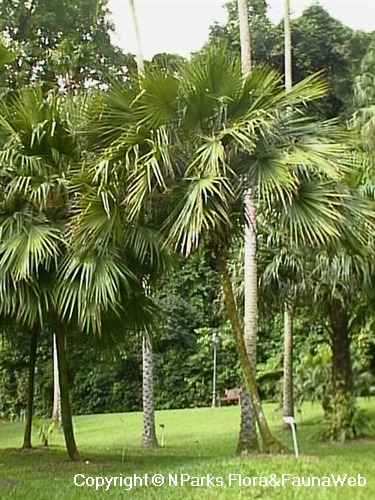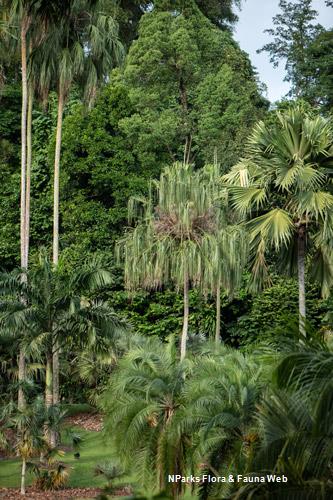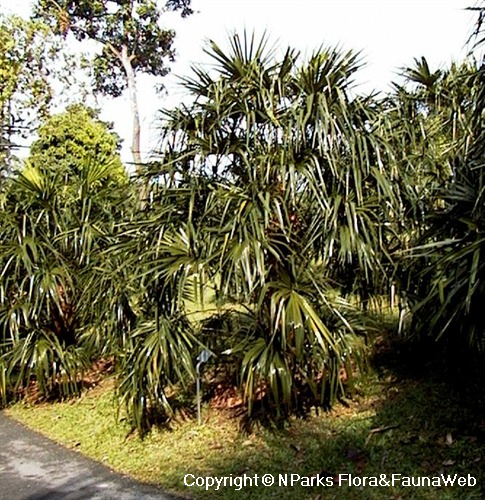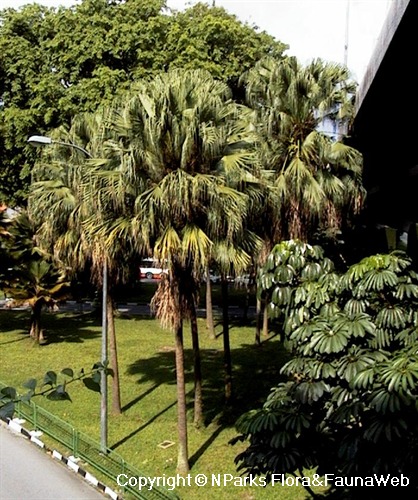Back
Livistona drudei F.Muell. ex Drude
| Family Name: | Arecaceae (Palmae) |
| Common Name: | Halifax Fan Palm, Cabbage Palm |
Livistona drudei, also known as Halifax Fan Palm, is a solitary palm that can reach up to 28 m tall. The petiole is distinctively purple at the basal area and its margin is armed with curved reddish spines. Coarse fibers are prominent and persistent at the base of the petiole.
Name
Classifications and Characteristics
| Plant Division | Angiosperms (Flowering Seed Plants) |
|---|---|
| Plant Growth Form | Palm |
| Lifespan (in Singapore) | Perennial |
| Mode of Nutrition | Autotrophic |
| Maximum Height | 28 m |
Biogeography
| Native Distribution | Australia |
|---|---|
| Native Habitat | Terrestrial |
| Preferred Climate Zone | Tropical |
| Local Conservation Status | Non-native |
Description and Ethnobotany
| Growth Form | It is a palm that can reach up to 28 m tall and has a solitary growth habit. Stem can reach up to 15 – 20 cm in diameter and is ringed with narrow leaf scars. |
|---|---|
| Foliage | Leaves are fan-shaped (costapalmate), about 1 – 1.5 m long, and deeply divided for 60 – 70% of the length. Leaves are regularly segmented and can have 60 – 84 segments each. The tip of the segment is pendulous with forked cleft (bifurcate). The petiole can reach 1.5 – 2.3 m long and is armed with curved reddish spines along the margin. Coarse fibers are prominent and persistent at the base of the petiole. The petiole is distinctively purple at the basal area. |
| Flowers | Inflorescence occurs between the leaves (interfoliar) and can reach 1.5 – 3 m long. It comprises of many small cream to yellow flowers. Flower is funnel-shaped (1.7 – 2.2 mm long) with fleshy petals and narrowly triangular sepals. |
| Fruit | Fruit is round to pear-shaped (pyriform) and can reach up to 1 – 1.1 cm diameter. The surface of the fruit has scattered lenticellular pores. Fruit also has suture line that extends to about half the length of the fruit. It turns purple-black when mature. Each fruit contains 1 seed within. |
| Habitat | It is found in coastal forests, landward side of mangrove forests, swamp forests and along streams and estuaries, up to 100 m altitude. |
| Associated Fauna | Flowers are pollinated by insects. |
| Cultivation | It can be propagated by seed. |
| Etymology | The genus commemorates Sir Patrick Murray (1632 – 1671), 2nd Lord of Elibank and 17th century Baron of Livingstone, who donated his private plant collection after his death and helped found the Edinburgh Botanic Garden. The specific epithet commemorates Carl Georg Oscar Drude (1852 – 1933), a German botanist and biogeographer, who contributed to the mapping of the world’s different floristic zones. |
Landscaping Features
| Landscape Uses | Coastal, General |
|---|---|
| Usage Hazard - Cons | Spines/Thorns - Leaf |
| Usage Hazard - Cons Remarks | Petioles are armed with short spines. |
Fauna, Pollination and Dispersal
| Pollination Method(s) | Biotic (Fauna) |
|---|
Plant Care and Propagation
| Light Preference | Full Sun |
|---|---|
| Water Preference | Moderate Water |
| Plant Growth Rate | Moderate |
Foliar
| Foliage Retention | Evergreen |
|---|---|
| Mature Foliage Colour(s) | Green |
| Foliar Type | Compound |
| Foliar Shape(s) | Palm Fronds (Fan / Costapalmate) |
| Leaf Area Index (LAI) for Green Plot Ratio | 2.5 (Palm - Solitary) |
Non - Foliar and Storage
| Trunk Type (Palm) | Solitary Habit, Aboveground |
|---|
Floral (Angiosperm)
| Flower Colour(s) | Cream / Off-White, Yellow / Golden |
|---|---|
| Flower Grouping | Cluster / Inflorescence |
Fruit, Seed and Spore
| Mature Fruit Colour(s) | Purple, Black |
|---|---|
| Fruit Type | Fleshy Fruit |
| Seed Quantity Per Fruit | Few (1-5) |
References
| References | Dowe, J.L. (2009). A taxonomic account of Livistona R.Br. (Arecaceae). Gardens' Bulletin Singapore 60: 185-344. |
|---|
Others
| Master ID | 1358 |
|---|---|
| Species ID | 2651 |
| Flora Disclaimer | The information in this website has been compiled from reliable sources, such as reference works on medicinal plants. It is not a substitute for medical advice or treatment and NParks does not purport to provide any medical advice. Readers should always consult his/her physician before using or consuming a plant for medicinal purposes. |




